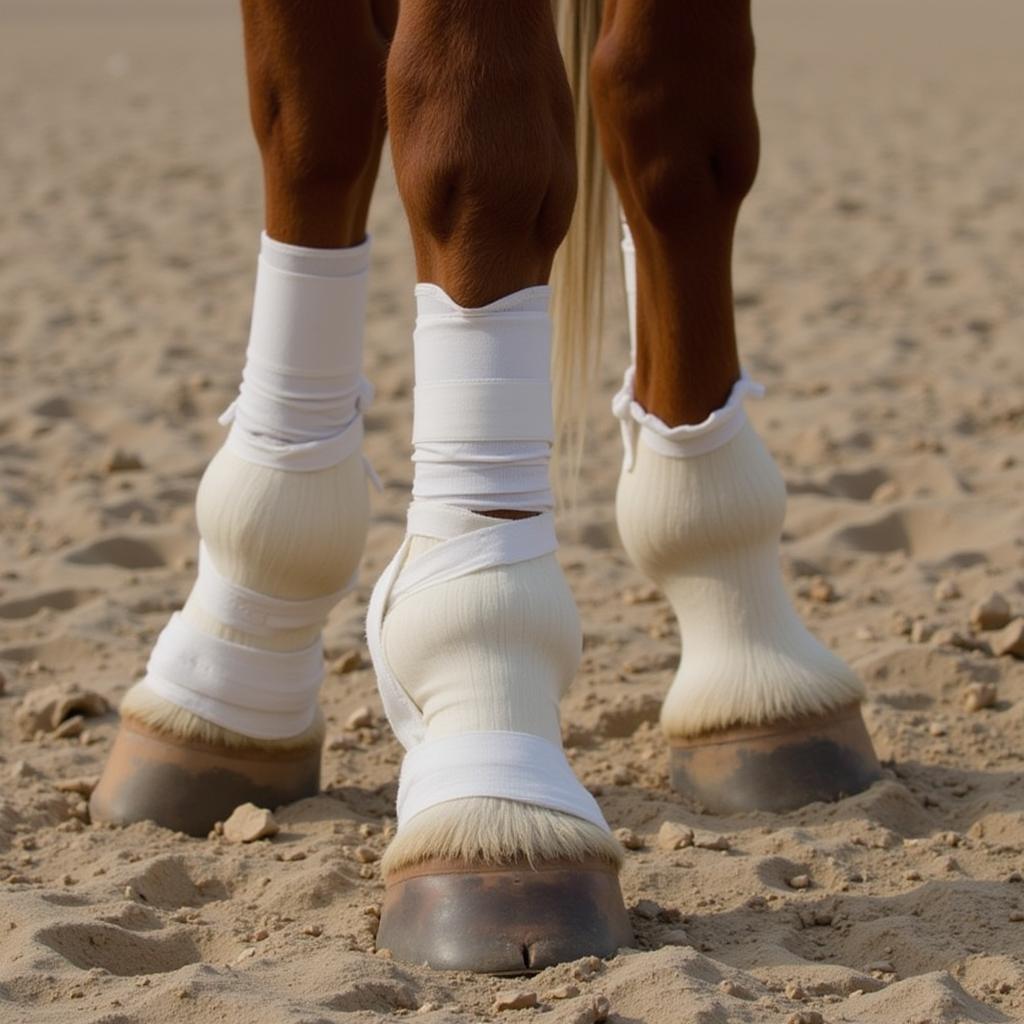OCD surgery in horses is a significant investment, both financially and emotionally. Understanding the factors influencing the cost, the procedure itself, and the potential outcomes is crucial for owners facing this decision. This article will delve into the specifics of OCD surgery costs, providing you with a comprehensive overview to help navigate this challenging process.
Understanding Osteochondrosis Dissecans (OCD) in Horses
Osteochondrosis dissecans (OCD) is a developmental orthopedic disease affecting young, growing horses. It involves abnormal cartilage and bone development within joints, leading to the formation of loose fragments or flaps of cartilage and bone, which can cause pain, lameness, and joint inflammation. These fragments, if left untreated, can contribute to the development of osteoarthritis later in life.
Factors Affecting OCD Surgery in Horses Cost
Several factors influence the overall cost of OCD surgery in horses. These include:
- Surgical Technique: Arthroscopic surgery, a minimally invasive procedure, is generally less expensive than traditional open surgery. However, the complexity of the lesion and the surgeon’s preference can impact the chosen technique.
- Diagnostic Imaging: Pre-operative diagnostics, such as X-rays, ultrasounds, and potentially MRI or CT scans, play a significant role in determining the extent of the OCD lesion and planning the surgical approach. These costs add to the overall expense.
- Hospitalization: The length of hospitalization required for post-operative care and monitoring contributes to the final bill. Factors such as the horse’s individual needs and the hospital’s daily rates will vary.
- Medications: Pain medication, antibiotics, and other post-operative medications are essential for recovery and will add to the overall cost.
- Geographic Location: Veterinary costs can vary significantly depending on geographic location and the expertise of the surgical team. Specialized equine hospitals or clinics in certain areas may charge higher fees.
- Post-Operative Rehabilitation: A structured rehabilitation program is crucial for a successful outcome after OCD surgery. This often involves controlled exercise, physical therapy, and potentially other modalities like shockwave therapy, which will incur additional costs.
What Does OCD Surgery in Horses Involve?
OCD surgery typically involves removing the loose cartilage and/or bone fragments and debriding (smoothing) the underlying bone to promote healthy cartilage growth. The specific surgical approach, whether arthroscopic or open surgery, depends on the location and severity of the OCD lesion.
How Much Does OCD Surgery in Horses Cost? A Breakdown
While providing an exact figure is challenging due to the aforementioned variables, a general estimate for OCD surgery in horses can range from $2,000 to $5,000 or more. This includes the surgical procedure, anesthesia, hospitalization, and initial post-operative care. Diagnostic imaging, medications, and rehabilitation will add to this cost.
Is OCD Surgery in Horses Worth It?
The decision of whether to pursue OCD surgery is a personal one that should be made in consultation with your veterinarian. Factors to consider include the horse’s age, intended use, severity of clinical signs, and the long-term prognosis. While surgery can significantly improve a horse’s quality of life and athletic potential, it’s essential to have realistic expectations and understand the potential risks and complications.
What are the Success Rates of OCD Surgery in Horses?
Success rates for OCD surgery in horses vary depending on the location of the lesion, the severity of the condition, and the individual horse. Generally, the prognosis is good, with many horses returning to full athletic function.
OCD Surgery in Horses: Long-Term Prognosis
The long-term prognosis for horses undergoing OCD surgery is generally favorable, particularly when diagnosed and treated early. A comprehensive rehabilitation program is vital for optimizing the healing process and minimizing the risk of re-injury or the development of osteoarthritis.
 Horse Leg Bandage Post-Operative Care
Horse Leg Bandage Post-Operative Care
Conclusion
OCD surgery in horses is a significant decision with associated costs and considerations. By understanding the factors affecting the cost, the surgical procedure, and the potential outcomes, owners can make informed choices for their horses’ well-being. Early diagnosis and intervention, combined with a dedicated rehabilitation program, can significantly improve the long-term prognosis for horses with OCD.
FAQ
- What is the average cost of OCD surgery in horses? The average cost ranges from $2,000 to $5,000, but it can vary depending on several factors.
- What is the recovery time for OCD surgery in horses? Recovery time varies, but horses typically require several months of restricted activity and a structured rehabilitation program.
- What are the signs of OCD in horses? Signs can include lameness, joint swelling, stiffness, and reduced range of motion.
- Is OCD surgery always necessary in horses? Not always. Conservative management may be an option for some horses with mild cases.
- What are the risks associated with OCD surgery in horses? Risks can include infection, complications with anesthesia, and implant failure (if implants are used).
- Can OCD be prevented in horses? While there’s no guaranteed prevention, proper nutrition, controlled exercise, and careful management of young, growing horses can help minimize the risk.
- What is the long-term outlook for horses after OCD surgery? The long-term outlook is generally good, especially with early diagnosis and treatment.
Common Scenarios and Questions:
- Scenario: Young horse showing intermittent lameness. Question: What diagnostic tests are needed to confirm OCD?
- Scenario: Horse diagnosed with OCD in the hock. Question: What are the surgical options available?
- Scenario: Horse recovering from OCD surgery. Question: What type of rehabilitation program is recommended?
Further Reading and Resources:
- Explore more articles on equine health on our website.
- Learn about other common equine orthopedic conditions.
Need help? Contact us at Phone: 0772127271, Email: [email protected] or visit our location: QGM2+WX2, Vị Trung, Vị Thuỷ, Hậu Giang, Việt Nam. Our customer service team is available 24/7.